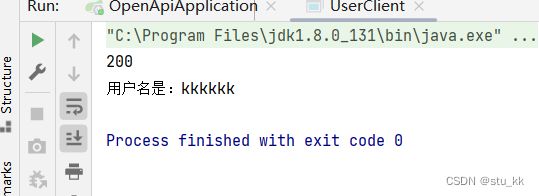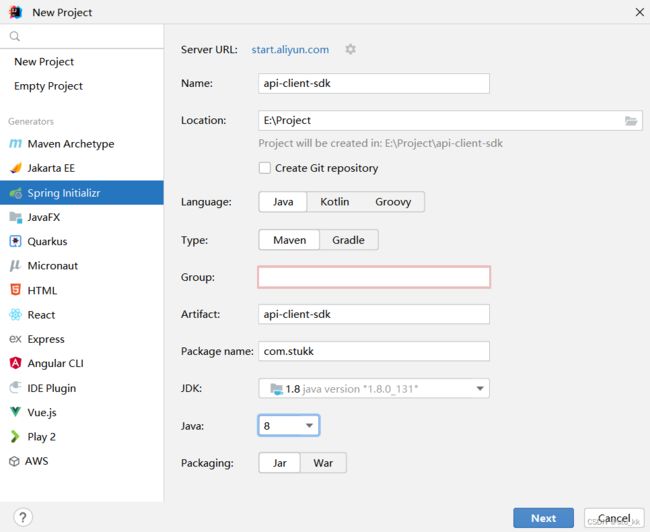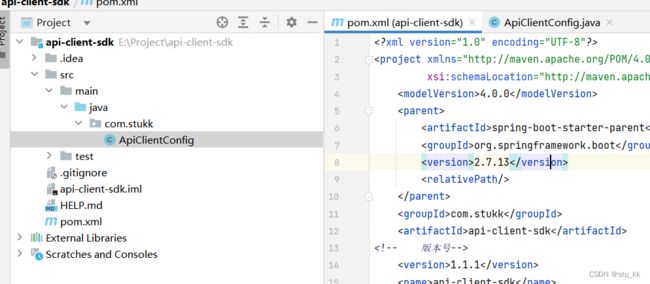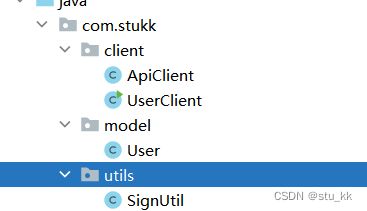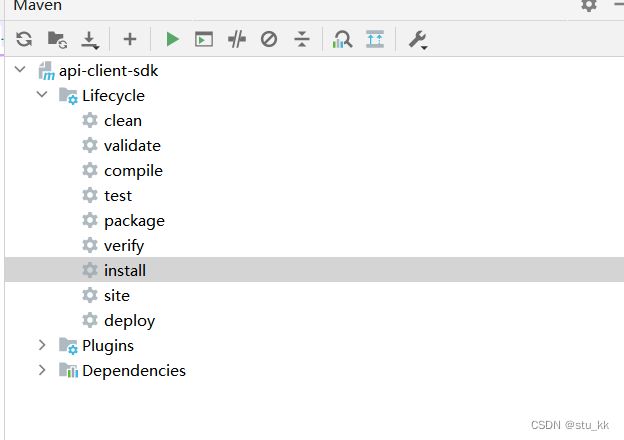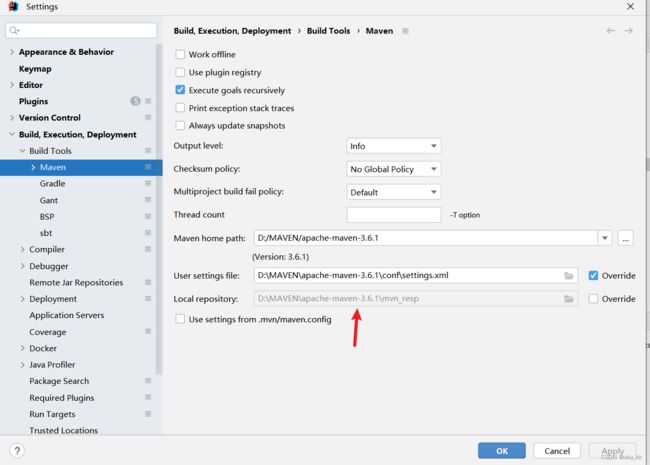开放API签名认证的设计并开发对应的SDK
1. 为什么需要签名认证呢?
假设我们开放了一个接口,而我们的服务器只允许处理1000个请求,如果这个时候由用户疯狂发送几万个请求,可能会导致服务器宕机,影响其他用户的正常使用。这个情况下我们需要对接口进行限流,而如果我们接口的内容很重要,有一定的保密性 ,这个时候就不可以随便让用户调用,需要让用户去申请签名认证来调取接口,通过接口的认证之后才可以访问到资源。
2. 代码设计
我们以一个简单的接口为例,一步一步从接口的开发到签名认证系统的设计:
2.1. 接口开发
首先我们先简单的创建get和post请求的接口:
package com.stukk.model;
import lombok.AllArgsConstructor;
import lombok.Builder;
import lombok.Data;
import lombok.NoArgsConstructor;
/**
* @Author: stukk
* @Description: 用户类(仅供测试)
* @DateTime: 2023-12-20 16:20
**/
@Data
@Builder
@AllArgsConstructor
@NoArgsConstructor
public class User {
private String userName;
}
package com.stukk.controller;
import com.stukk.model.User;
import org.springframework.web.bind.annotation.*;
/**
* @Author: stukk
* @Description: 测试开发API的接口
* @DateTime: 2023-12-20 16:20
**/
@RestController
@RequestMapping("/user")
public class UserController {
@GetMapping("/")
public String getNameByGet(String name){
return "用户名是:"+name;
}
@PostMapping("/name")
public String getNameByPost(@RequestParam String name){
return "用户名是:"+name;
}
@PostMapping("/")
public String getUserNameByPost(@RequestBody User user){
return "用户名是:"+user.getUserName();
}
}
application.yml文件配置:
server:
port: 8099
servlet:
context-path: /api
启动springboot之后,我们在浏览器输入:localhost:8099/api/user/?name=stukk
2.2. 第三方接口的客户端开发
每次让用户使用http去调用显然不太好,我们需要封装方法给用户传参调用就行了。
package com.stukk.client;
import cn.hutool.http.HttpRequest;
import cn.hutool.http.HttpResponse;
import cn.hutool.http.HttpUtil;
import cn.hutool.json.JSONUtil;
import com.stukk.model.User;
import org.springframework.web.bind.annotation.RequestParam;
import java.util.HashMap;
import java.util.Map;
/**
* @Author: stukk
* @Description: 第三方接口客户端
* @DateTime: 2023-12-20 16:33
**/
public class ApiClient {
public String getNameByGet(String name){
// Get请求
Map paramMap = new HashMap<>();
paramMap.put("name",name);
String result = HttpUtil.get("http://localhost:8099/api/user/", paramMap);
System.out.println(result);
return result;
}
public String getNameByPost( String name){
// Post请求
Map paramMap = new HashMap<>();
paramMap.put("name",name);
String result = HttpUtil.post("http://localhost:8099/api/user/name", paramMap);
System.out.println(result);
return result;
}
public String getUserNameByPost(User user){
// Post请求
String jsonStr = JSONUtil.toJsonStr(user);
Map paramMap = new HashMap<>();
HttpResponse httpResponse = HttpRequest.post("http://localhost:8099/api/user/").body(jsonStr).execute();
System.out.println(httpResponse.getStatus());
String result = httpResponse.body();
System.out.println(result);
return result;
}
public static void main(String[] args) {
ApiClient apiClient = new ApiClient();
apiClient.getNameByGet("stukk");
apiClient.getNameByPost("吴坤坤");
apiClient.getUserNameByPost(User.builder().userName("kkkkkk").build());
}
}
运行结果:
好了,我们已经实现了接口的开发和调用了,但是上述例子只是一个简单的例子,具体情况还需要根据项目需求去添加内容。
2.3.简单的校验
上述接口最大的问题就是,任何人、任何时间都可以来访问我的接口,这样子相当于接口在裸奔了,安全性是没有的,所以我们可以初步一些简单的校验功能:
加上公钥和私钥:
private String accessKey; //公钥
private String secretKey; //私钥
public ApiClient(String accessKey, String secretKey) {
this.accessKey = accessKey;
this.secretKey = secretKey;
}然后我们现在接口处加上很呆的判定:
@PostMapping("/") public String getUserNameByPost(@RequestBody User user, HttpServletRequest request){ String accessKey = request.getHeader("accessKey"); String secretKey = request.getHeader("secretKey"); if(!accessKey.equals("stukk") || !secretKey.equals("kkkkkk")){ throw new RuntimeException("无权限"); } return "用户名是:"+user.getUserName(); }
之后运行就无权限了:
但是显然这种虽然能有效的防止别人随意调用,但是只要有人拦截了我们的请求,获取到请求头中的ak和sk,那么就能随意调用了,所以密码是不能以明文的形式传输的!不传递怎么确定是合规的访问呢?
2.4.标准的API签名认证
在标准的 API 签名认证中,我们需要传递一个签名(Sign)。通常我们不是直接将密钥传递给后台,而是根据密钥生成一个签名。我们可以使用MD5单向加密算法来加密密钥生成签名,单向意味着只可加密不可解密的,所以我们需要保存用户的密钥,在判定时,再加密一次对比加签名既可以判断是不是合规的请求了。
为了更加的安全,我们还可以
1. 在请求头加上随机数,后端只接受随机数一次,这样可以解决请求重放问题,更加的安全了
2. 每个请求在发送时携带一个时间戳,并且后端会验证该时间戳是否在指定的时间范围内,例如不超过10分钟或5分钟。这可以防止对方使用昨天的请求在今天进行重放。
详情见代码:
/**
* @Author: stukk
* @Description: 签名工具
* @DateTime: 2023-12-20 17:47
**/
public class SignUtil {
public static String genSign(String body,String secretKey){
// 使用基于SHA256的MD5算法
Digester md5 = new Digester(DigestAlgorithm.SHA256);
String content = body + "." + secretKey;
// 加密得到签名
return md5.digestHex(content);
}
}
/**
* @Author: stukk
* @Description: 第三方接口客户端
* @DateTime: 2023-12-20 16:33
**/
public class ApiClient {
private String accessKey; //公钥
private String secretKey; //私钥
public ApiClient(String accessKey, String secretKey) {
this.accessKey = accessKey;
this.secretKey = secretKey;
}
public String getNameByGet(String name){
// Get请求
Map paramMap = new HashMap<>();
paramMap.put("name",name);
String result = HttpUtil.get("http://localhost:8099/api/user/", paramMap);
System.out.println(result);
return result;
}
public String getNameByPost( String name){
// Post请求
Map paramMap = new HashMap<>();
paramMap.put("name",name);
String result = HttpUtil.post("http://localhost:8099/api/user/name", paramMap);
System.out.println(result);
return result;
}
public String getUserNameByPost(User user){
// Post请求
String jsonStr = JSONUtil.toJsonStr(user);
HttpResponse httpResponse = HttpRequest.post("http://localhost:8099/api/user/")
.addHeaders(getHeaders(jsonStr))
.body(jsonStr)
.execute();
System.out.println(httpResponse.getStatus());
String result = httpResponse.body();
System.out.println(result);
return result;
}
private Map getHeaders(String body){
Map map = new HashMap<>();
map.put("accessKey",accessKey);
// 不能直接加上密钥
map.put("secretKey",secretKey);
// 生成随机数,4个随机数字字符串
map.put("nonce", RandomUtil.randomNumbers(4));
// 请求体
map.put("body",body);
// 时间戳
map.put("timestamp",String.valueOf(System.currentTimeMillis()/1000));
// 签名:
map.put("sign", SignUtil.genSign(body,secretKey));
return map;
}
}
package com.stukk.controller;
import com.stukk.model.User;
import com.stukk.utils.SignUtil;
import org.springframework.web.bind.annotation.*;
import javax.servlet.http.HttpServletRequest;
import javax.servlet.http.HttpServletResponse;
import java.util.HashMap;
import java.util.HashSet;
import java.util.Set;
/**
* @Author: stukk
* @Description: 测试开发API的接口
* @DateTime: 2023-12-20 16:20
**/
@RestController
@RequestMapping("/user")
public class UserController {
@GetMapping("/")
public String getNameByGet(String name){
return "用户名是:"+name;
}
@PostMapping("/name")
public String getNameByPost(@RequestParam String name){
return "用户名是:"+name;
}
@PostMapping("/")
public String getUserNameByPost(@RequestBody User user, HttpServletRequest request){
String accessKey = request.getHeader("accessKey");
String nonce = request.getHeader("nonce");
String timestamp = request.getHeader("timestamp");
String sign = request.getHeader("sign");
String body = request.getHeader("body");
Set nonces = new HashSet<>();
// 数据库查询验证这个accessKey
if(!accessKey.equals("stukk")){
throw new RuntimeException("无权限");
}
// 检验随机数,判断是不是出现过
if(nonces.contains(nonce)){
throw new RuntimeException("请重试");
}
nonces.add(nonce);
long preTimestamp = Long.parseLong(timestamp);
long nowTimestamp = System.currentTimeMillis()/1000;
if(nowTimestamp - preTimestamp > 36000){ //10小时?
throw new RuntimeException("签名超时");
}
//根据accessKey从数据库查出secretkey,这里假设为kkkkkk
String secretLKey = "kkkkkk";
String correctSign = SignUtil.genSign(body, secretLKey);
if(!correctSign.equals(sign)){
throw new RuntimeException("签名错误");
}
return "用户名是:"+user.getUserName();
}
}
/**
* @Author: stukk
* @Description:
* @DateTime: 2023-12-20 17:09
**/
public class UserClient {
public static void main(String[] args) {
String accessKey = "stukk"; //公钥
String secretKey = "kkkkkk"; //私钥
ApiClient apiClient = new ApiClient(accessKey, secretKey);
apiClient.getUserNameByPost(User.builder().userName("kkkkkk").build());
}
} 这样子我们就完成了标准的API签名认证了,接下来开发SDK:
3.开发SDK
3.1.新建项目
3.2.配置pom.xml配置文件
4.0.0
spring-boot-starter-parent
org.springframework.boot
2.7.13
com.stukk
api-client-sdk
1.1.1
api-client-sdk
api-client-sdk
1.8
org.springframework.boot
spring-boot-starter
org.springframework.boot
spring-boot-configuration-processor
true
org.projectlombok
lombok
true
3.3.创建配置类
package com.stukk;
import lombok.Data;
import org.springframework.boot.context.properties.ConfigurationProperties;
import org.springframework.context.annotation.ComponentScan;
import org.springframework.context.annotation.Configuration;
/**
* @Author: stukk
* @Description: 创建配置类
* @DateTime: 2023-12-20 19:04
**/
//标记为配置类
@Configuration
@ConfigurationProperties("stukk.api") //能够读取application.yml配置,载入属性
@Data //lombok注解
@ComponentScan //自动扫描组件
public class ApiClientConfig {
private String accessKey;
private String secretKey;
}
项目中的 client包、model包、utils包复制:
在resources目录下创建META-INF/spring.factories文件:
org.springframework.boot.autoconfigure.EnableAutoConfiguration=com.stukk.ApiClientConfig3.4.下载jar包
下载的地方就是我们maven配置的地方:
4.引入SDK
接下来回到原来的项目,删掉model、client、utils包,引入这个SDK依赖:
com.stukk
api-client-sdk
1.1.1
我们会发现application.yml会提示我们生成这个accessKey和secretKey配置:
server:
port: 8099
servlet:
context-path: /api
stukk:
api:
access-key: stukk
secret-key: kkkkkk
3.5编写测试类测试:
package com.stukk;
import com.stukk.client.ApiClient;
import com.stukk.model.User;
import org.junit.jupiter.api.Test;
import org.springframework.boot.test.context.SpringBootTest;
import javax.annotation.Resource;
@SpringBootTest
class OpenApiApplicationTests {
@Resource
private ApiClient apiClient;
@Test
void testSDK() {
User user = new User(kk__SDK");
String result = apiClient.getUserNameByPost(user);
System.out.println(result);
}
}
成功调用了。





